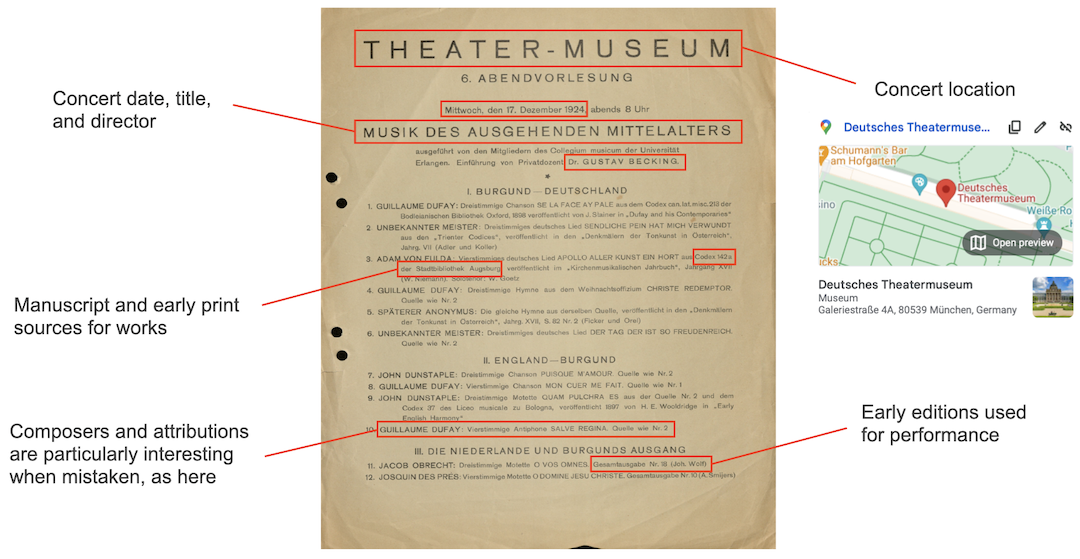about
We’re often told how informal performance in musicology seminars played an important role in the revival of medieval and Renaissance music performance in the years following World War I.
But this project argues that performance in more formal contexts was also essential in the rediscovery of early music. And a whole additional category of evidence for this survives in abundance, but has until now largely been ignored: programs for public concerts between 1915 and 1960—often introduced, directed, performed, or heard by the very same scholars leading important seminars—and which included music from before 1600. To better understand the emergence of the early music performance tradition on both sides of the Atlantic, we need to systematically collect and curate all this information in a way that moves beyond narrative descriptions of a few individual concerts.
The project
This project, founded in 2023 by Benjamin Ory, aims to meet this challenge by creating a relational database and mapping tool that will allow users to selectively display patterns of carefully-curated data from these programs. Users will be able to query the database to ask questions about the popularization of repertoires; the use of new performance and scholarly editions; the figures involved in the concerts; the early music objects that scholars and performers referenced and transcribed from; and the establishment of local, national, and international early music canons.
Collecting this information is not simple: these programs are rarely published or digitized, but are instead often only found buried in personnel and institute files in university archives. This project seeks to collate and map materials, and provide context for important concerts. It also aims to enable users to flexibly manipulate this data to answer their own research questions.
What’s on a concert program?
Surviving programs are remarkably detailed. Most provide information about performance locations, which frequently included churches, museums, and university lecture halls. Programs list ensembles, directors, performers, and who introduced the concert. They sometimes describe the early music sources (manuscripts, early prints) from which scholars drew their transcriptions and name the scholar responsible for the transcriptions. Ensembles performing from existing modern editions often cite their sources, too.
Why 1915 to 1960?
Sporadic performances of medieval and Renaissance music can be traced back to the ninteenth and even the eighteenth centuries, but until the 1910s, concerts of these repertoires were rare. All of this changed in Europe in the years following World War I: early music rapidly came into vogue. A generation of young scholars, captivated by informal music making movements such as the Jugendmusikbewegung and emerging scholarship on music history, began to direct concerts and devote themselves to specialized knowledge about music from before 1600. The project’s chronological bound of 1915 reflects this newfound interest.
Interest in early music on both sides of the Atlantic increased rapidly throughout the 1950s, and by the 1960s, the number performances had exploded. Ending the project’s focus at 1960 enables the project to concentrate on the emergence of the modern early music tradition without being overwhelmed by the expansive concert data in ensuing decades.
Entering programs
For each program of early music:
- works are identified by their standardized modern name, if possible; citations of modern editions are provided.
- The probable composer for each work is listed, as agreed by modern scholars. Should there be more than one plausible conflicting attribution, these are provided as well.
- music editions and original sources are named, if offered.
- concert participants are identified.
- details about performance location are entered.
The archives
Concert programs have been located so far in the following archives:
Are there other concert programs that should be included in this project? Let us know.
Support
This project has been supported by a 2023 Ora Frishberg Saloman Fund Award from the American Musicological Society.
